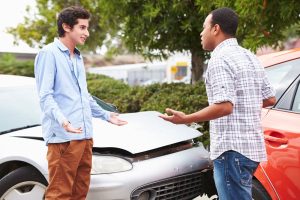Even though many people have some idea about making a personal injury claim there are certain situations when it is not clear who may be liable. In this blog post we will look at some common situations many of us might find ourselves in and consider who is liable, why they are liable, and what to look out for. However, it is worth noting that wherever your accident occurs and whoever you claim against, you will still need evidence to support your case and take professional legal advice.
Personal Injury Occurs On Private Property
In this instance private property could be anything from a car park to a campsite, from a cottage to a farm. It is basically property which is not under the direct control of local authorities or national government. The effective liability for any accidents falls on the property owner. However, this is not as straightforward as many might assume!
The Occupiers’ Liability Acts 1957 And 1984
These acts place upon the owner of private property a lawful obligation covering a duty of care to both lawful, authorised, and in some circumstances unlawful visitors. It does introduce something of a grey area with the term “reasonably safe” which can in some circumstances be argued either way. The idea behind these acts is that all private property should be well maintained for the purposes of which people are invited, permitted, or in some cases unlawfully use the property.
Negligence On Private Property
In many ways the laws covering private property are very similar to those covering the workplace and public areas. Where there are potentially unavoidable hazards there should be warning signs highlighting the dangers and advising visitors to proceed with caution. These issues could be something as simple as an uneven floor, slippery tiles, some kind of spillage or any other potential danger. If the owner can demonstrate that visitors were made aware of potential dangers this can in many cases mitigate personal injury claims. There may be times when a warning sign is just not enough but it is at least a starting point in the owner’s defence.
Children And Unlawful Visitors
The law appreciates that children are “less careful” than adults and therefore simply erecting warning signs may not be enough. If for example there were toxic materials on private property and the owner was aware of children in the area there would be a duty of care to rectify the issue. If a child was injured then there would probably be a strong case for a personal injury claim depending upon any actions taken by the owner.
The area of unlawful visitors is a very controversial subject and one which regularly appears in the mass media. Any reasonable person could be mistaken for assuming that an unlawful visitor to a private property should have no protections. Unfortunately some might say, the law sees this in a different way and in some circumstances where an unlawful visitor is injured on private property there may be a case for a personal injury claim prosecution. These generally relate to potentially dangerous issues which the owner was aware of but did nothing to address.
Over the years we have heard stories of local authorities being forced to keep school lighting, exterior and interior, on during the day and night to ensure as much as possible that trespassers are not injured. This in itself has been a very controversial subject and highlighted more than most the difference between rule of law and the rule of “common sense”.
Personal Injury Occurs During A Test Drive
As the car market gets more and more competitive many of us will be given the opportunity to test drive new vehicles in the hope that we will eventually buy them. We have traditional internal combustion engine vehicles and now we have electric cars and hydrogen powered transportation. The issue of who is responsible for an injury which occurs during a test drive is an interesting and not altogether straightforward subject.
If You Are To Blame For The Incident
There will be occasions where the test driver is injured but ultimately they are to blame for the accident. In these circumstances traditional motor vehicle insurance regulations come into play in that you should be covered by your own car insurance policy if other parties are injured or there is damage to the vehicle. If you are looking to take a new vehicle for a test drive, or perhaps you have a hire car booked, you should make sure that your car insurance policy covers such activities. If not, you can add short-term cover to your policy or there may be an opportunity to arrange cover with the company providing the vehicle.
In some circumstances where it would appear that the test driver was responsible for an accident the situation could change if you could prove the vehicle was faulty or not well maintained – or perhaps the company representative played a role. In this circumstance you may be able to counter sue the company involved to cover any claim against your insurance by an injured third party.
If You Were Not To Blame For The Incident
Interestingly there is the potential to claim from two parties if you were involved in an accident and sustained an injury which was not your fault. As with a traditional car insurance claim you would simply take action against the third party driver and in a successful prosecution you would receive compensation. In some circumstances, where the hire vehicle or the vehicle you were test driving was not maintained correctly, or partially at fault, you could receive compensation from the company involved.
Personal Injury Occurs While A Passenger In A Uber Taxi
Since its launch back in 2009 Uber has taken the peer-to-peer car sharing market to a whole new level (some would call the company a taxi firm but Uber does not agree). This service has had a massive impact upon traditional taxi operations and with more people using Uber we are starting to see the number of accidents and injuries associated with an Uber journey increase. So, who is liable if you are injured as a passenger in an Uber vehicle?
Uber maintains that it is not a taxi service and is basically a provider of technology for peer-to-peer car sharing activities. As a consequence, all individuals who utilise the Uber technology to find “taxi” customers need to have their own car insurance in place in case of an accident. If the Uber driver is responsible for an accident in which you receive an injury then you will be able to claim off their insurance for loss of earnings, injuries, etc. However, there have been instances where, despite checks by Uber, some drivers have been picking up fares without the necessary insurance in place. In this instance Uber has its own secondary insurance which customers should be able to fall back upon in the event of injury. The problem is that because Uber sees itself as a technology provider and not a customer service operator it can be difficult to get hold of and report your accident to Uber. If you are an injured passenger and have been offered a refund on your fair in settlement of an injury claim, never accept any compensation in the immediate aftermath of an accident! Contact a solicitor first as they can advise on what compensation you should be paid.
If you received an injury in an Uber “taxi” you should report this as soon as possible, take as much evidence as you can, note the contact details of witnesses and report it to the police and Uber. Just because you are in an Uber “taxi” does not mean the law of the land is somehow irrelevant.
Personal Injury Occurs When You Trip On The Pavement
Over the years councils and local authorities have paid out millions of pounds on injuries sustained on public highways. One of the main problems in years gone by, and still a major issue today, is that of slips/ trips accidents which occur as a consequence of pavements which are not maintained correctly. They may be cracked, there may be slabs missing, loose stones or some other issue which could cause injury. This area has been seen as a “golden goose” type situation by fraudsters and while it is still perfectly legitimate to make a claim for injuries received in this manner, the local authorities are now more robust in their defence.
If you make a claim for injury caused by a faulty pavement then you should take photographs, witness statements and make sure it is reported to the authorities as soon as possible. Many personal injury solicitors will be able to give you advice on how to proceed with a claim and who is potentially liable.
Legal Warning
One word of warning for those who have private property, such as a shop or other premises, in the vicinity of local authority maintained highways/ pavements. You should be wary of cleaning or 
So, from a legal point of view you are better to leave the pavement in a dangerous condition than use “common sense” and do your public duty. The law really is bizarre!



